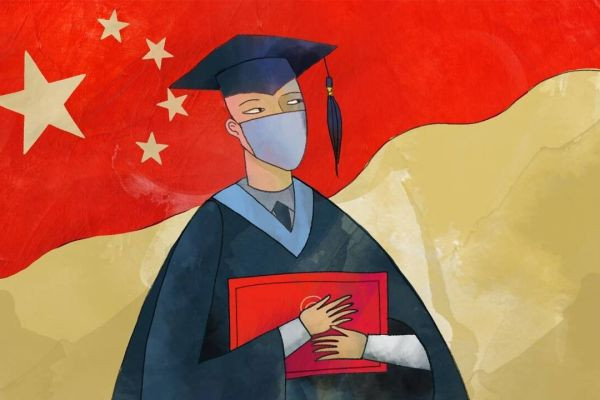Introduction
Youth unemployment in China has reached a new record high as the country's post-pandemic recovery faces obstacles. Official figures reveal that the jobless rate for individuals aged 16 to 24 in urban areas rose to 21.3% last month. Concurrently, China's second-largest economy experienced modest growth of just 0.8% in the second quarter of the year. Analysts suggest that the sluggish pace of growth has heightened expectations for new economic stimulus measures from the authorities. This article examines the concerning rise in youth unemployment in China and its implications for the country's workforce and economy.
The Struggle for Post-Pandemic Recovery
China, like many other countries, has been striving to recover from the economic fallout caused by the COVID-19 pandemic. The pandemic resulted in widespread business disruptions, reduced consumer spending, and a decline in global trade, all of which have impacted the country's overall economic performance. Despite initial signs of recovery, China now faces a concerning setback as youth unemployment skyrockets.

Youth Unemployment Reaches New Heights
The impact of pandemic has hit young people in China particularly hard, with youth unemployment surging to unprecedented levels. The combination of pandemic-related job losses, increased competition for limited positions, and a mismatch between skills and market demands has exacerbated the challenges faced by young job seekers.
The reasons behind this record-high youth unemployment are multi-faceted. The pandemic has forced many businesses, especially in industries like hospitality, tourism, and retail, to downsize or shut down altogether. This has led to a scarcity of entry-level job opportunities, making it difficult for young people to secure employment.
Additionally, the transition towards a more technology-driven and service-based economy in China has created a demand for specialized skills. However, many young job seekers lack the necessary qualifications and training required for these emerging sectors, leading to a mismatch between available jobs and the skill sets of the workforce.
Unsettling Unemployment Statistics
Recent official data released by China's National Bureau of Statistics highlights a troubling trend: the jobless rate among urban youth has surged to a record high. Last month, the rate reached 21.3% for individuals aged 16 to 24. This alarming figure coincides with the country's lackluster economic growth of 0.8% in the second quarter. The disappointing economic performance has prompted analysts to anticipate forthcoming measures from the government to revitalize the economy.
Impact on the Economy and Expectations
China's second-quarter growth of 6.3% on an annual basis, while surpassing the first-quarter figure, fell short of analysts' expectations. Economists express concern over underwhelming retail sales, housing investment, and other indicators that indicate weak underlying growth momentum. The decline in global demand for Chinese goods, combined with mounting local government debt and housing market challenges, further exacerbates the situation. The record number of university graduates, estimated at 11.58 million this year, entering the job market amplifies the significance of youth unemployment in China.
Factors Contributing to Youth Unemployment
Youth unemployment has been on the rise for several months, stemming from various factors, including a mismatch between graduates' skills and available job opportunities. Analysts predict a continued increase in youth unemployment in the coming months, potentially peaking around August. While unemployed young people represent only 1.4% of China's potential urban workforce, economists emphasize the need for direct policy responses due to the vocal nature of this population, which can influence broader economic confidence.
Government Measures and Challenges
China began publishing youth unemployment data in 2018, but currently, data on the employment status of young people in rural areas is not available. In March, Premier Li Qiang acknowledged the necessity of redoubling efforts to achieve the country's 5% economic growth target for the year, admitting that it would be challenging. The central bank's recent interest rate cut aimed to encourage spending, but experts believe that the government still possesses additional tools to stimulate the economy if the situation fails to improve
Implications for Workforce and Economic Stability
China's exports are no longer in demand on the international market. The housing market and the soaring local government debt are further worries. Economists are keeping a close eye on youth employment as a record 11.58 million university graduates are anticipated to enter the job market in China this year.
For several months, the unemployment rate for young people in metropolitan areas has been rising. This is a result of various things, such as a disconnect between the employment that are currently accessible and what graduates were taught to do.
Authorities acknowledge that the rate of youth unemployment is likely to increase over the upcoming months before peaking around August.
According to Dan Wang, chief economist at Hang Seng Bank China, the percentage of young people without jobs in China's urban areas is merely 1.4%.
Addressing the Challenges
To mitigate the rising youth unemployment crisis, the Chinese government has recognized the urgency of implementing measures to stimulate job creation and improve the employability of young people. Efforts are being made to encourage entrepreneurship, provide vocational training programs, and foster partnerships between educational institutions and industries to align skill development with market needs.
Furthermore, promoting economic diversification, encouraging innovation and digitalization, and creating an environment conducive to small and medium-sized enterprises (SMEs) can generate more employment opportunities, particularly for the youth.
Conclusion
The record-high youth unemployment rate in China poses significant challenges to both the affected individuals and the overall economy. The sluggish post-pandemic recovery and mismatch between graduates' skills and available jobs contribute to this worrisome trend. The government's commitment to meeting economic growth targets and implementing policy responses remains crucial. As China grapples with youth unemployment, the nation's authorities must address the issue to restore confidence and foster a more resilient and inclusive economy.
As China faces the challenges of post-pandemic recovery, the record-high youth unemployment rate presents a significant hurdle in its path toward economic stability and social cohesion. The government's proactive measures and ongoing initiatives to stimulate job creation, enhance vocational training, and foster innovation are crucial in addressing the root causes of the issue. By investing in the youth and aligning skills with evolving market demands, China can work towards a more inclusive and resilient economy, ensuring a brighter future for its young workforce and the nation as a whole.
 Bitcoin: $97706.29 1.25%
Bitcoin: $97706.29 1.25%  Ethereum: $3408.16 2.91%
Ethereum: $3408.16 2.91%  Tether: $1.00 0.06%
Tether: $1.00 0.06%  Solana: $255.82 0.41%
Solana: $255.82 0.41%  BNB: $652.89 4.53%
BNB: $652.89 4.53%  XRP: $1.45 1.31%
XRP: $1.45 1.31%  Dogecoin: $0.42 3.88%
Dogecoin: $0.42 3.88%  USDC: $1.00 0%
USDC: $1.00 0%  Cardano: $1.04 8.02%
Cardano: $1.04 8.02%  Lido Staked ETH: $3389.32 2.44%
Lido Staked ETH: $3389.32 2.44%  TRON: $0.21 6.91%
TRON: $0.21 6.91%  Avalanche: $41.73 5.76%
Avalanche: $41.73 5.76%  Stellar: $0.51 68.87%
Stellar: $0.51 68.87%  Shiba Inu: $0.00 2.77%
Shiba Inu: $0.00 2.77%  Wrapped Bitcoin: $97526.37 1.15%
Wrapped Bitcoin: $97526.37 1.15%  Polkadot: $8.49 34.76%
Polkadot: $8.49 34.76%  Chainlink: $17.58 12.23%
Chainlink: $17.58 12.23%  Bitcoin Cash: $506.64 3.7%
Bitcoin Cash: $506.64 3.7%  UNUS SED LEO: $8.61 1.42%
UNUS SED LEO: $8.61 1.42%  NEAR Protocol: $6.12 8.17%
NEAR Protocol: $6.12 8.17%  Litecoin: $98.39 8.84%
Litecoin: $98.39 8.84%  Uniswap: $10.86 14.5%
Uniswap: $10.86 14.5%  Multi Collateral DAI: $1.00 0%
Multi Collateral DAI: $1.00 0%  Internet Computer: $11.24 11.89%
Internet Computer: $11.24 11.89%  Crypto.com Coin: $0.19 3.14%
Crypto.com Coin: $0.19 3.14%  Sp8de: $0.59 12.84%
Sp8de: $0.59 12.84%  Ethereum Classic: $29.59 5.79%
Ethereum Classic: $29.59 5.79%  VeChain: $0.04 28.35%
VeChain: $0.04 28.35%  Artificial Superintelligence Alliance: $1.37 10.39%
Artificial Superintelligence Alliance: $1.37 10.39%  Filecoin: $5.34 12.95%
Filecoin: $5.34 12.95%  Stacks: $2.07 6.15%
Stacks: $2.07 6.15%  OKB: $50.50 9.6%
OKB: $50.50 9.6%  Monero: $160.03 0.87%
Monero: $160.03 0.87%  Aave: $175.48 6.4%
Aave: $175.48 6.4%  Algorand: $0.30 23.85%
Algorand: $0.30 23.85%  Fantom: $0.87 20.93%
Fantom: $0.87 20.93%  The Graph: $0.24 12.29%
The Graph: $0.24 12.29%  Hedera Hashgraph: $0.15 11.63%
Hedera Hashgraph: $0.15 11.63%  Injective: $27.76 13.55%
Injective: $27.76 13.55%  Cosmos: $8.15 11.27%
Cosmos: $8.15 11.27%  THORChain: $5.61 6.32%
THORChain: $5.61 6.32%  THETA: $1.89 12.19%
THETA: $1.89 12.19%  MANTRA DAO: $3.63 0.75%
MANTRA DAO: $3.63 0.75%  Raydium: $5.97 0.99%
Raydium: $5.97 0.99%  Maker: $1648.86 0.63%
Maker: $1648.86 0.63%  Arweave: $21.98 24.98%
Arweave: $21.98 24.98%  Bitcoin SV: $70.64 4.38%
Bitcoin SV: $70.64 4.38%  KuCoin Token: $11.48 3.55%
KuCoin Token: $11.48 3.55%  Polygon: $0.57 21.47%
Polygon: $0.57 21.47%  Flow: $0.82 14.36%
Flow: $0.82 14.36%  Quant: $100.98 17.91%
Quant: $100.98 17.91%  Gala: $0.03 15.52%
Gala: $0.03 15.52%  Lido DAO: $1.33 8.29%
Lido DAO: $1.33 8.29%  EOS: $0.76 7.13%
EOS: $0.76 7.13%  Tezos: $1.14 3.13%
Tezos: $1.14 3.13%  Neo: $14.49 8.82%
Neo: $14.49 8.82%  Axie Infinity: $6.64 12.43%
Axie Infinity: $6.64 12.43%  Helium: $5.78 6.36%
Helium: $5.78 6.36%  The Sandbox: $0.41 14.91%
The Sandbox: $0.41 14.91%  Decentraland: $0.51 18.3%
Decentraland: $0.51 18.3%  GateToken: $10.99 8.76%
GateToken: $10.99 8.76%  Akash Network: $3.89 4.57%
Akash Network: $3.89 4.57%  AIOZ Network: $0.81 12.53%
AIOZ Network: $0.81 12.53%  eCash: $0.00 2.98%
eCash: $0.00 2.98%  Nexo: $1.35 3.5%
Nexo: $1.35 3.5%  Pendle: $5.27 4.93%
Pendle: $5.27 4.93%  MultiversX: $35.42 17.1%
MultiversX: $35.42 17.1%  Mina: $0.72 6.79%
Mina: $0.72 6.79%  FTX Token: $2.47 2.24%
FTX Token: $2.47 2.24%  Zcash: $48.02 5.95%
Zcash: $48.02 5.95%  Conflux: $0.17 9.75%
Conflux: $0.17 9.75%  Chiliz: $0.08 11.02%
Chiliz: $0.08 11.02%  IOTA: $0.22 18.92%
IOTA: $0.22 18.92%  Gnosis: $273.80 5.08%
Gnosis: $273.80 5.08%  Oasis: $0.10 14.06%
Oasis: $0.10 14.06%  XinFin Network: $0.05 16.46%
XinFin Network: $0.05 16.46%  SuperVerse: $1.32 7.38%
SuperVerse: $1.32 7.38%  PancakeSwap: $2.16 11.02%
PancakeSwap: $2.16 11.02%  Curve DAO Token: $0.50 13.01%
Curve DAO Token: $0.50 13.01%  Nervos Network: $0.01 6.1%
Nervos Network: $0.01 6.1%  Kusama: $39.22 79.34%
Kusama: $39.22 79.34%  Compound: $63.98 18.49%
Compound: $63.98 18.49%  Kava: $0.49 7.4%
Kava: $0.49 7.4%  TrueUSD: $1.00 0.02%
TrueUSD: $1.00 0.02%  NXM: $73.20 4.93%
NXM: $73.20 4.93%  Theta Fuel: $0.07 5.26%
Theta Fuel: $0.07 5.26%  DeXe: $8.28 0.17%
DeXe: $8.28 0.17%  1inch Network: $0.36 6.49%
1inch Network: $0.36 6.49%  Synthetix: $1.98 9.94%
Synthetix: $1.98 9.94%  Zilliqa: $0.02 14.47%
Zilliqa: $0.02 14.47%  WOO: $0.24 11.64%
WOO: $0.24 11.64%  Celo: $0.79 10.21%
Celo: $0.79 10.21%  Reserve Rights: $0.01 8.96%
Reserve Rights: $0.01 8.96%  Trust Wallet Token: $1.01 4.33%
Trust Wallet Token: $1.01 4.33%  Livepeer: $11.62 10.75%
Livepeer: $11.62 10.75%  IoTeX: $0.04 4.01%
IoTeX: $0.04 4.01%  Amp: $0.01 7.83%
Amp: $0.01 7.83%  Holo: $0.00 10.16%
Holo: $0.00 10.16%  Enjin Coin: $0.23 14.11%
Enjin Coin: $0.23 14.11%  Dash: $33.05 13.66%
Dash: $33.05 13.66% 








